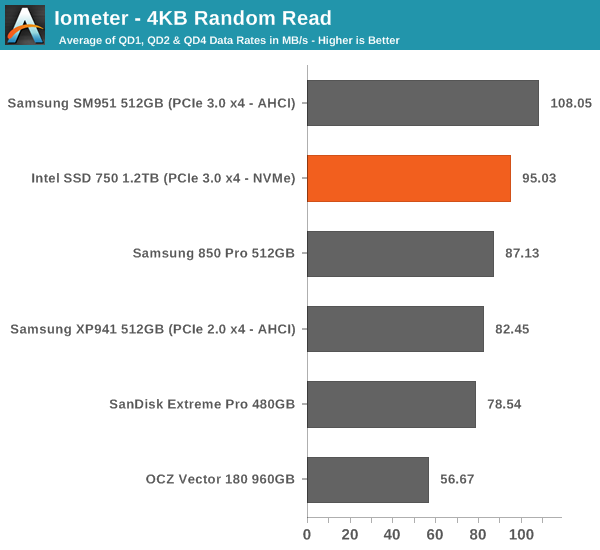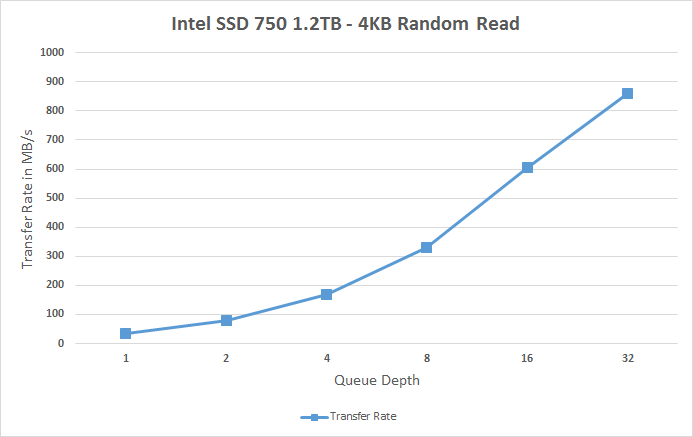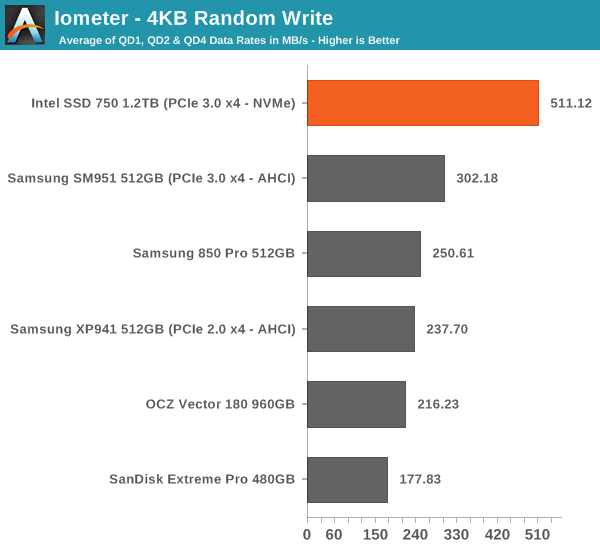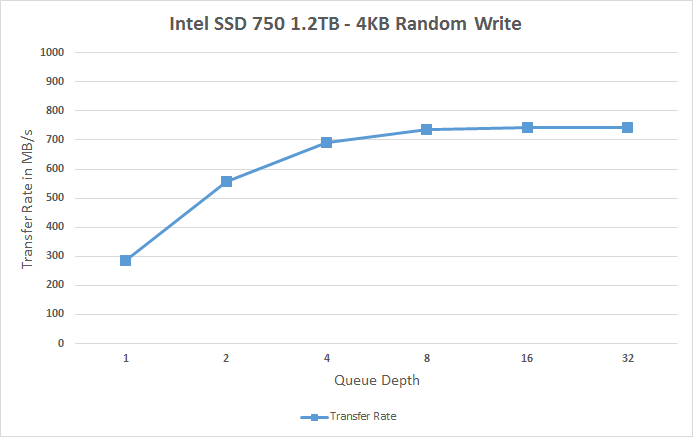Intel SSD 750 PCIe SSD Review: NVMe for the Client
by Kristian Vättö on April 2, 2015 12:00 PM ESTRandom Read Performance
One of the major changes in our 2015 test suite is the synthetic Iometer tests we run. In the past we used to test just one or two queue depths, but real world workloads always contain a mix of different queue depths as shown by our Storage Bench traces. To get the full scope in performance, I'm now testing various queue depths starting from one and going all the way to up to 32. I'm not testing every single queue depth, but merely how the throughput scales with the queue depth. I'm using exponential scaling, meaning that the tested queue depths increase in powers of two (i.e. 1, 2, 4, 8...).
Read tests are conducted on a full drive because that is the only way to ensure that the results are valid (testing with an empty drive can substantially inflate the results and in reality the data you are reading is always valid rather than full of zeros). Each queue depth is tested for three minutes and there is no idle time between the tests.
I'm also reporting two metrics now. For the bar graph, I've taken the average of QD1, QD2 and QD4 data rates, which are the most relevant queue depths for client workloads. This allows for easy and quick comparison between drives. In addition to the bar graph, I'm including a line graph, which shows the performance scaling across all queue depths. To keep the line graphs readable, each drive has its own graph, which can be selected from the drop-down menu.
I'm also plotting power for SATA drives and will be doing the same for PCIe drives as soon as I have the system set up properly. Our datalogging multimeter logs power consumption every second, so I report the average for every queue depth to see how the power scales with the queue depth and performance.

Despite having NVMe, the SSD 750 doesn't bring any improvements to low queue depth random read performance. Theoretically NVMe should be able to improve low QD random read performance because it adds less overhead compared to the AHCI software stack, but ultimately it's the NAND performance that's the bottleneck, although 3D NAND will improve that by a bit.
 |
|||||||||
The performance does scale nicely, though, and at queue depth of 32 the SSD 750 is able to hit over 200K IOPS. It's capable of delivering even more than that because unlike AHCI, NVMe can support more than 32 commands in the queue, but since client workloads rarely go above QD32 I see no point in test higher queue depths just for the sake of high numbers.
Random Write Performance
Write performance is tested in the same way as read performance, except that the drive is in a secure erased state and the LBA span is limited to 16GB. We already test performance consistency separately, so a secure erased drive and limited LBA span ensures that the results here represent peak performance rather than sustained performance.

In random write performance the SSD 750 dominates the other drives. It seems Intel's random IO optimization really shows up here because the SM951 doesn't even come close. Obviously the lower latency of NVMe helps tremendously and since the SSD 750 features full power loss protection it can also cache more data in DRAM without the risk of data loss, which yields substantial performance gains.
 |
|||||||||
The SSD 750 also scales very efficiently and doesn't stop scaling until queue depth of 8. Note how big the difference is at queue depths of 1 and 2 -- for any random write centric workload the SSD 750 is an absolute killer.










132 Comments
View All Comments
p1esk - Friday, April 3, 2015 - link
Let me say that again: this is a consumer drive. That's why it is so cheap compared to 3700. A large Hollywood production company will surely be able to afford enough of these drives not to worry about exceeding 128TB write limits.emn13 - Saturday, April 4, 2015 - link
I'm sure they can afford it - but why pay more than necessary? Compared to the competition, this is an unusally low write endurace for such a high-end drive. Take a peek at say the 1TB 850 Pro; that's likely to be considerably cheaper (and perhaps more deserving of the "consumer" monniker), and it's NAND is rated for a little more than 6000TB of (raw) writes.128TB? That's really, really unusual for a drive like this.
earl colby pottinger - Tuesday, April 7, 2015 - link
Because that is how you run your company out of business by being cheap of key hardware.If you are producing enough 4K video to stress this drive, you are producing enough video that the cost of production is way greater that the cost of drives that you don't have to worry about this type of failure.
I have seen tons of companies go out of business or lose out on thousands of dollars in sales because they tried to save a few hundred dollars up-front against my advice.
Stop looking for cheap solutions if the storage is critical to the running of your business.
emn13 - Saturday, April 4, 2015 - link
I do a lot of large-file snapshot/restore stuff, and I definitely write a lot more than 70gb a day. Intel's own consumer level 335 was rated for 700TB, and that was a much smaller drive. More specifically, this hasn't been a problem on other drives - neither on ssd's, nor on hdds. While it's conceivable there are more efficient ways of working from the perspective of the drive, that's a hassle to arrange.Perhaps it's worth pointing you to the SSD endurance experiment: http://techreport.com/review/26523/the-ssd-enduran...
All of these drives approximately 240GB drives survived at least 700gb, and it was specifically the intel that seemingly intentionally bricked itself then.
This drive is 5 time larger, and is rated for a fraction of that. This is pretty unreasonable to my mind.
darkgreen - Thursday, April 2, 2015 - link
This part of the review made be curse:"...with the X25-M. It wasn't the first SSD on the market, but it was the first drive that delivered the aspects we now take for granted: high, consistent and reliable performance."
Arrrgh...
I was one of the early adopters who paid a ton for the XM-25. If you go back through the archives, though, you'll see Intel's XM-25 had a fragmentation bug that made it slower than a spinning platter hard drive after a bit of use. I was in that situation. Intel released a "fix" based on a script run on some old freeware, but they didn't support the fix *at all* and for many people (including me) it would never work.
So INTEL's "high, consistent and reliable performance" turned out to be total crap. I paid over $400 for what turned out to be a doorstop and had to replace it with a Corsair SSD a short time later. INTEL never offered a refund, support, or even an apology to all the people they had sold a totally nonfunctional product to. I still have that drive in my electronic junk pile and I curse INTEL every time it catches my eye.
I'm waiting for good PCIe SSD before my next PC build, unfortunately I would say INTEL products don't count because in the past we've seen (inarguably, and documented on this very site!) that they mass release buggy products and if you happen to have bought one you're just hung out to dry when they turn out to have had major design errors.
Ugh. at least mention the history here and caution people instead of suggesting Intel is reliable.
Makaveli - Thursday, April 2, 2015 - link
anecdotal evidence!!I've have two G2 160GB intel drives in Raid 0 for a couple years now and they been solid no issues.
So I disagree with your post do I win ?
darkgreen - Friday, April 3, 2015 - link
I wasn't expected that kind of reply. Google "intel replicated SSD firmware problem" (without the quotes) and you can read about the various things that happened, many of which were first reported at this very site, but I guess it WAS 6 years ago so I shouldn't expect everyone to know about it.I was running win 7 64-bit and had a G1. You'll see reports that ALL G1's had a fragmentation issue that made them slower than spinning platters after a bit of use, and you'll see mainstream media reports about how the "fix" instead bricked drives for many users on win 7 64-bit .
Not anecdotes, mainstream reporting and I was one of the thousands affected and can confirm that even after those reports Intel did nothing for non-enterprise users but delete the 50-page thread on their support site.
Kristian Vättö - Thursday, April 2, 2015 - link
To put it frankly, there's no SSD (or HDD) manufacturer that hasn't had any issues, so you might as well go back to the good ol' pen&paper if you want something truly reliable ;-)Raniz - Thursday, April 2, 2015 - link
Until the pen explodes and you have to buy a new shirtdarkgreen - Friday, April 3, 2015 - link
Agreed. In coming up with a good google search for the guy above who apparently hadn't heard about this I encountered a lot of articles about necessary firmware updates for other vendors as well. All I know is that Intel left consumers without options or replacements, I don't know what happened in all those other cases. I suppose it's a good reason to think about how important the storage division is to any company you buy from, though. Intel might, conceptually, want to support SSDs but I'd imagine all the management focus is on enterprise and processors. So who do you go with? OCZ (yikes! but maybe okay after the buyout?) Any thoughts on which companies actually value consumer purchases of their SSDs as "mission-critical" ?